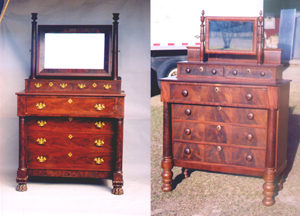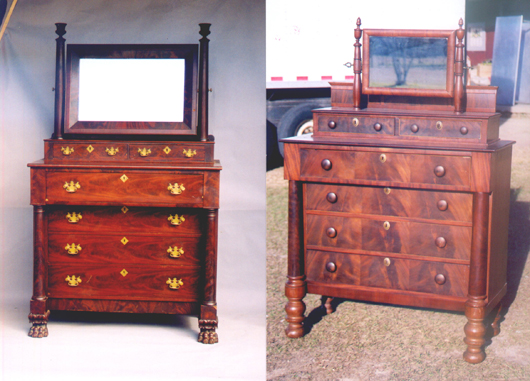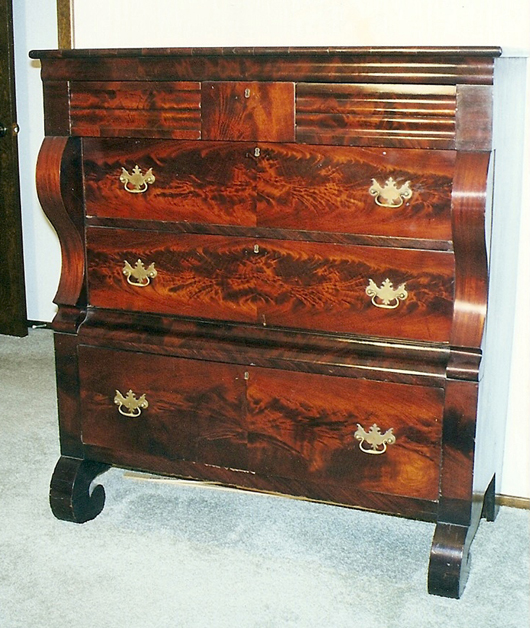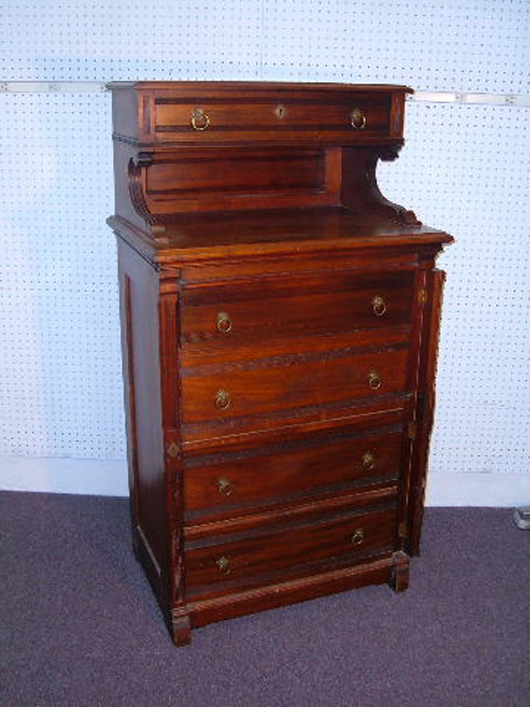
In the last few months I have been fortunate enough to attend several high-end antique shows, cover some good auctions and visit a well-known museum with a wonderful collection of 18th- and 19th-century American furniture treasures. And while it is fun to sort of let yourself go and just be amazed at all the great “stuff,” the inquiring mind of a skeptic curmudgeon requires that not every piece on display or for sale be accepted at face value.
I often find myself studying a piece with the attitude that somewhere in the history of that 200-year-old chest of drawers or game table, somebody made a mistake or took a shortcut and it will reveal itself if I know where to look and how to look. I don’t use this approach to bargain for a better price on something because I am not looking to add to my collection right now and I certainly would never make a disparaging comment to a museum curator about something being improperly labeled or questionably restored. But it is fun to just play a private game of “find the faux pas” and let it go at that. However, you may find another use for the result of the game if you choose.
The most likely areas on a piece of furniture to reveal alteration or substitution are the ones most likely to suffer in daily use or the ones most easily “upgraded” or replaced. Those areas are drawer pulls, hinges, casters, panes of glass and the finish. For right now let’s just concentrate on drawer pulls, the main “brasses.”
When examining an antique, keep in mind that the older the piece, the more likely the handles have been replaced. There may have been many reasons for replacing a set of handles on a piece, most quite innocent and maybe a few less so. One reason for replacement is the “freshening up” that used to be a periodic ritual with old furniture. Old, tarnished or broken pulls were replaced with more modern ones to give the piece an updated look. Sometimes the aging process went the other way, placing pulls from a previous style or period on a contemporary piece to change the appearance. There may have been other legitimate reasons why a drawer has pulls that would seem to be from another period or style. Among those reasons is the fact that the cabinetmaker may have just used whatever he had on hand. Another is that most Colonial brass pulls were imported from England and they were often altered or cut to make do.
Drawer pulls are most commonly made of brass, an alloy of copper and zinc, a tradition that dates to the William and Mary period when round drop pulls were cast. These early round or pear-shape pulls were usually flat or hollow on the back and were mounted on a thin brass backplate that often was “chased” for additional decoration. Around the turn of the 18th century the cast bail handle appeared, attached to a drawer front with cotter pins clinched on the inside, similar to the earlier drop pulls. The ends of these early bails curved inward to complete the handle. Early in the Queen Anne period the bail was attached to posts with rounded heads that accepted the protruding ears of the bail which by now were curved outward, hanging from the inner sides of the posts. This configuration lasted for most of the rest of the 18th century, reversing itself again for Hepplewhite pulls at the beginning of the Federal era. The Queen Anne post and bail hardware had a thicker brass backplate than William and Mary examples and the posts were often threaded to attach a crudely made nut on the inside of the drawer. Later Queen Anne and Chippendale backplates were not chased. The shapes became the main decorative element with Chippendale adding elaborate piercings.
Early and mid-18th-century brasses were cast in a sand mold using a wooden model of the hardware to form the mold. Sand cast hardware often has “inclusions” from impurities found in the sand. The backs of flat sand cast brasses have the texture of the sand in the mold while the edges will show the marks left by a file as it was shaped and smoothed. The flat surfaces were almost never completely flat, exhibiting a wavy pattern left by the smoothing operation which can be both seen and felt.
Two important changes in brass hardware occurred in the second half of the century. The composition of the brass was changed around mid-century with the addition of more copper to the alloy, producing a slightly redder brass than the pale yellow of the early century and rolled sheet brass became available around 1780. This meant that each piece was no longer cast but cut, greatly reducing the cost and increasing the availability. While this new method still resulted in some filing and final shaping visible around the edges, the backs were now as smooth as the fronts.
By the Federal era high pressure rollers produced the elaborate raised panel Hepplewhite back plates for American furniture, ironically produced mostly in Birmingham, England, complete with patriotic eagles, flags and drums. Periods of style after Federal, beginning with Empire, placed much less emphasis on brass hardware, downsizing to knobs and ring pulls. Rococo Revival and Renaissance Revival used even less. Elaborate stamped brass did not regain popularity until the Eastlake and Aesthetic movements and the onset of the Colonial Revival.
If the style of the brass looks right and the apparent age of the brass fits with the apparent age of the piece, how can you tell if the brass is original or has been replaced? Since it is much easier to detect replaced hardware than to identify original brasses, start there beginning with the least invasive technique, working through successively more invasive methods.
The least invasive technique is simply careful observation of the brass and the surrounding area of the wood and finish. Since most people do not remove the hardware every time a piece is cleaned or waxed, a handle that has been in place, undisturbed for a very long time will have a buildup of wax, brass polish and dirt around the edges. That’s a good clue but valuable only in its presence, not in its absence, because the original brasses could have been removed, the case cleaned and the brasses polished and reinstalled, resulting in crisp edges with no build up. Examine the surrounding area for signs on the surface of different hardware such as indentations made by other back plates, bruises in the wood from other bails as they drop and a change in color where another piece of hardware protected the finish in a different spot.
The next step is to open a drawer for a peek at the backside. The most common clue to other hardware is the presence of additional holes that may have accommodated a different size plate or holes that have been plugged. Then check the attaching system employed to hold the hardware in place. Is it consistent with the period of the piece? Do any of the older holes show evidence of clinched cotter pins that have been replaced by more modern threaded posts and nuts? Older handmade nuts tend to be round and may even have a slot in them. Newer machine-made hardware has square nuts on the post inside the drawer and the threads on the posts are perfectly symmetrical.
Finally, if appropriate, remove the hardware and examine both the brass and the wood underneath. If older, smaller brass was replaced with a bigger piece, there could be a shadow or outline of the older pull visible in the wood, especially if it had sharp rear facing edges like the pressed Hepplewhite backplates. Then take a look at the back of the hardware for evidence of sand casting or milling on the plate. Older posts started at the backplate as square and tapered as they were threaded to accept the round nuts. More modern posts start out round and accept the square nuts.
Most modern reproduction hardware is easy to spot. The backplates are stamped, not cast and the posts are pressed into fittings on the backplate and of course they look like they just came from the local hardware store. However there are some dedicated craftsmen currently producing excellent quality handmade cast reproductions of period hardware using molds made from the real thing. One of the better of these is Londonderry Brasses of Cochranville, Pa.
Familiarize yourself with the correct hardware style for the period of the furniture and learn to tell modern reproduction hardware from period pieces.
For more information about old hardware and brasses see the following books:
Fake, Fraud or Genuine, Myrna Kaye, Bulfinch Press
Early American Furniture, John Obbard, Collector Books
Old Furniture-Understanding the Craftsman’s Art, Nancy Smith, Dover Publications
Send your comments, questions and pictures to Fred Taylor at P.O. Box 215, Crystal River, FL 34423 or email them to him at info@furnituredetective.com.
Visit Fred’s website at www.furnituredetective.com. His book How To Be a Furniture Detective is available for $18.95 plus $3 shipping. Send check or money order for $21.95 to Fred Taylor, P.O. Box 215, Crystal River, FL 34423.
Fred and Gail Taylor’s DVD, Identification of Older & Antique Furniture ($17 + $3 S&H) is also available at the same address. For more information call 800-387-6377, fax 352-563-2916, or info@furnituredetective.com. All items are also available directly from his website.
ADDITIONAL IMAGES OF NOTE





